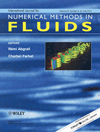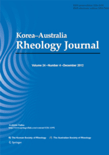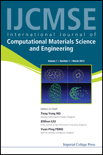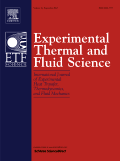
APPLIED RHEOLOGY
Scope & Guideline
Elevating Understanding of Material Dynamics
Introduction
Aims and Scopes
- Rheological Characterization of Complex Fluids:
Research on the flow and deformation behavior of non-Newtonian fluids, including polymers, suspensions, and emulsions, employing various rheological testing methods to characterize their properties. - Application of Rheology in Engineering and Geosciences:
Exploration of rheological principles in engineering applications, such as soil mechanics, structural integrity, and hydraulic systems, focusing on how material behavior affects design and safety. - Nanofluids and Advanced Materials:
Investigation of rheological properties of nanofluids and other advanced materials, studying their flow characteristics and potential applications in thermal management and energy systems. - Computational and Experimental Methods:
Utilization of both computational modeling and experimental techniques to analyze and predict rheological behavior, enhancing understanding of complex interactions within materials. - Environmental and Health Applications:
Exploration of rheological aspects in environmental contexts, such as soil behavior under stress, and in health-related applications like blood flow and cosmetic formulations.
Trending and Emerging
- Advanced Nanofluids Research:
There is a growing emphasis on the study of nanofluids, particularly their thermal and rheological properties, indicating a trend towards developing materials with enhanced performance for applications in energy systems and cooling technologies. - Rheology in Geological and Environmental Contexts:
An emerging focus on the application of rheology to geological materials and environmental engineering, particularly in understanding soil behavior under various stress conditions and its implications for construction and natural resource management. - Integration of Computational Modeling with Experimental Techniques:
A trend towards combining computational fluid dynamics with experimental rheology to provide more accurate predictions of material behaviors under complex conditions, enhancing the relevance of research findings in practical applications. - Innovations in Rheological Measurement Techniques:
The development and application of novel measurement technologies, such as in-situ rheological assessments and advanced imaging techniques, are on the rise, allowing for more precise characterizations of complex fluids. - Interdisciplinary Applications of Rheology:
An increasing trend towards interdisciplinary research that applies rheological principles to diverse fields such as medicine, food science, and materials engineering, reflecting the versatility and importance of rheology in solving complex problems.
Declining or Waning
- Traditional Newtonian Fluid Studies:
Research focusing on classical Newtonian fluids has become less prominent, as the field increasingly emphasizes complex and non-Newtonian fluid behaviors, which have broader applications and greater relevance in modern engineering. - Single-Phase Flow in Ideal Conditions:
Studies that explore fluid behavior under idealized single-phase conditions are waning, as researchers are now more interested in multi-phase interactions and the complexities of real-world applications. - Static Mechanical Properties of Homogeneous Materials:
Research dedicated solely to the static properties of homogeneous materials, without considering their dynamic or rheological responses, has seen a decline, as the field shifts towards more comprehensive analyses that include time-dependent behaviors. - Limited Focus on Historical Data Analysis:
There has been a noticeable decrease in studies relying on historical data analysis of rheological properties, with a trend towards more innovative experimental designs and computational studies.
Similar Journals

JOURNAL OF ENHANCED HEAT TRANSFER
Pioneering Insights in Heat Transfer TechnologyThe JOURNAL OF ENHANCED HEAT TRANSFER, published by BEGELL HOUSE INC, is a prominent resource for researchers and professionals in the fields of mechanical engineering, fluid flow and transfer processes, and condensed matter physics. With a history spanning from 1993 to 2024, this journal offers a platform for disseminating cutting-edge research and innovations that enhance our understanding of heat transfer phenomena. Although it operates under a traditional subscription model, its impressive standing is underscored by its Scopus rankings—positioned within the 59th percentile for Mechanical Engineering and 58th percentile for Fluid Flow and Transfer Processes. Additionally, it holds Q2 and Q3 categorizations in relevant fields, reflecting its importance in advancing knowledge and applications in heat transfer technology. This journal effectively bridges the gap between theoretical insights and practical solutions, making it an indispensable tool for academics, industrial practitioners, and students eager to explore advancements in thermal management and efficiency.

HEAT TRANSFER RESEARCH
Fostering Excellence in Heat Transfer ResearchHEAT TRANSFER RESEARCH is a leading academic journal published by Begell House Inc that focuses on the dynamic and evolving fields of heat transfer, fluid flow, and mechanical engineering. With an ISSN of 1064-2285 and an E-ISSN of 2162-6561, this journal serves as a critical platform for researchers and professionals seeking to disseminate innovative findings and advancements in these interrelated disciplines. Covering converged years from 1992 to 2024, HEAT TRANSFER RESEARCH has established its impact in the academic community, achieving a 2023 ranking of Q3 in Condensed Matter Physics and Q2 in Fluid Flow and Transfer Processes. It currently occupies a percentile rank ranging from 44th to 54th across several Scopus categories, underscoring its relevance and contribution to the scientific discourse. While Open Access options are not available, the journal remains committed to providing high-quality research and insights that shape the future of thermal sciences. Accessible to both seasoned professionals and aspiring students, HEAT TRANSFER RESEARCH is indispensable for anyone looking to stay ahead in the ever-changing landscape of engineering and applied physics.

INTERNATIONAL JOURNAL FOR NUMERICAL METHODS IN FLUIDS
Navigating the Complexities of Fluid Flow with PrecisionINTERNATIONAL JOURNAL FOR NUMERICAL METHODS IN FLUIDS, published by Wiley, has established itself as a leading platform for cutting-edge research in the fields of applied mathematics, computational mechanics, computer science applications, and mechanical engineering. With its ISSN 0271-2091 and E-ISSN 1097-0363, this journal is committed to disseminating high-quality, peer-reviewed articles that contribute to the advancement of numerical methodologies in fluid dynamics. Boasting a commendable 2023 impact factor that places it in the second quartile across multiple relevant categories, it provides insights into significant research dimensions that engage an audience of researchers, professionals, and students keen on the computational challenges of fluid flow. The journal's broad scope encompasses foundational and applied research, encouraging the exploration of new numerical techniques and algorithms. As an invaluable resource based in the United Kingdom, INTERNATIONAL JOURNAL FOR NUMERICAL METHODS IN FLUIDS remains dedicated to providing insights and fostering innovation in its domain, with a consistent publication history spanning from 1981 to 2024.

JOURNAL OF ELASTICITY
Exploring the Dynamics of Materials and MechanicsJOURNAL OF ELASTICITY is a prestigious peer-reviewed journal dedicated to the study and advancement of the field of elasticity and its numerous applications across various disciplines. Published by SPRINGER, and located in the Netherlands, this journal has been a key resource since its inception in 1971, providing critical insights and developments up through 2024. With a commendable impact factor and categorized within the Q2 quartile in areas such as Materials Science, Mechanical Engineering, and Mechanics of Materials, the journal maintains a significant standing in the academic community. Researchers and professionals will find a wealth of knowledge through advanced theoretical and experimental studies published within its pages, contributing to both foundational understanding and practical applications. While currently not an open access publication, the JOURNAL OF ELASTICITY remains an essential platform for innovative research and discussions that shape the future of mechanical sciences.

KOREA-AUSTRALIA RHEOLOGY JOURNAL
Fostering impactful discoveries in rheology since 2003.KOREA-AUSTRALIA RHEOLOGY JOURNAL, published by the Korean Society of Rheology, serves as a pivotal platform for disseminating high-quality research in the realms of Condensed Matter Physics and Materials Science. Established in 2003 and running through to 2024, this journal has made notable strides with a 2023 ranking of Q3 in both categories within Scopus, indicating its impactful contributions to the scientific community. Although currently not an open-access journal, it stands out for its rigorous peer-reviewed articles that span a diverse range of topics, fostering advancements in rheology across various applications. Researchers, professionals, and students alike can expect to engage with insightful studies and cutting-edge findings through this essential publication based in South Korea, headquartered at the Korea Science Technology Center in Seoul. As the field evolves, KOREA-AUSTRALIA RHEOLOGY JOURNAL remains a critical resource for those looking to stay abreast of developments and innovations in rheological science.

Physical Review Fluids
Advancing Knowledge in Fluid MechanicsPhysical Review Fluids is an esteemed journal published by the American Physical Society, focusing on the intricate and essential field of fluid dynamics. With an impressive Q1 ranking in categories such as Computational Mechanics, Fluid Flow and Transfer Processes, and Modeling and Simulation, this journal serves as a pivotal resource for researchers and professionals seeking to disseminate high-quality and innovative research findings. The journal's scope encompasses a broad spectrum of topics within fluid mechanics, promoting advancements in theoretical, computational, and experimental methodologies. Although it is not an open-access journal, its publications are critically well-received, underpinned by its strong standing in the Scopus rankings which place it in the top percentiles across various relevant fields. Physical Review Fluids has been a foundational platform for scholars to share their discoveries from 2016 through 2024, making it an indispensable asset in the ongoing evolution of fluid dynamics research.

Fluid Dynamics
Connecting engineers and scientists through fluid dynamics.Fluid Dynamics is a distinguished journal that has been at the forefront of research in the field of fluid flow and transfer processes since its inception in 1966. Published by MAIK NAUKA/INTERPERIODICA/SPRINGER, this journal serves as a valuable platform for engineers, scientists, and researchers dedicated to advancing the understanding of mechanical and fluid dynamic phenomena. With a Q3 ranking in key categories such as Fluid Flow and Transfer Processes, Mechanical Engineering, and Physics and Astronomy, Fluid Dynamics holds a significant position in the academic community, attracting submissions that push the boundaries of knowledge and application. Although it does not currently offer open access options, the journal is recognized for its robust editorial standards and impactful contributions to the field, making it essential reading for anyone involved in fluid dynamics research. Given its consistent publication through to 2024, Fluid Dynamics continues to inspire innovation and collaboration in an ever-evolving scientific landscape.

International Journal of Computational Materials Science and Engineering
Elevating interdisciplinary collaboration through cutting-edge research.International Journal of Computational Materials Science and Engineering (ISSN: 2047-6841; E-ISSN: 2047-685X) is a pioneering academic journal published by World Scientific Publishing Co. Pte Ltd, based in Singapore. With a dedicated focus on the intersection of computational techniques and materials science, the journal serves as a crucial platform for disseminating cutting-edge research and developments from both theoretical and practical perspectives. The journal's rigorous peer-review process and commitment to high-quality submissions ensure the publication of influential articles that can significantly impact their fields of study. As of 2023, the journal holds a Q4 ranking in Computer Science Applications and Q3 in Materials Science (miscellaneous), along with notable rankings in other categories such as Mechanics of Materials and Numerical Analysis. Although not Open Access, it facilitates a rich repository of knowledge essential for researchers and professionals aiming to advance their work in computational methods and materials engineering. With converged years from 2012 to 2024, the journal continues to build on its reputation by fostering interdisciplinary collaborations and innovations.

EXPERIMENTAL THERMAL AND FLUID SCIENCE
Advancing experimental frontiers in thermal and fluid sciences.EXPERIMENTAL THERMAL AND FLUID SCIENCE is a prestigious academic journal published by Elsevier Science Inc, dedicated to advancing the fields of thermal and fluid sciences. With a strong focus on innovative experimental research, it plays a crucial role in disseminating new knowledge and techniques across multiple domains, including Aerospace Engineering, Chemical Engineering, Fluid Flow and Transfer Processes, Mechanical Engineering, and Nuclear Engineering. Holding a notable impact factor and ranking in the Q1 quartile across these categories since 2023, the journal is recognized for its high-quality contributions, which appeal to a diverse audience of researchers, industry professionals, and students alike. Additionally, with dedicated coverage from its inception in 1988 to projections extending through 2025, EXPERIMENTAL THERMAL AND FLUID SCIENCE provides a vital platform for sharing advancements in experimental techniques and findings that shape the future of engineering and applied sciences.

JOURNAL OF ENGINEERING MECHANICS
Connecting Theory and Practice in Engineering MechanicsJOURNAL OF ENGINEERING MECHANICS, published by the ASCE - American Society of Civil Engineers, stands as a premier interdisciplinary journal in the field of engineering mechanics. With an impact factor reflecting its vital contributions—placing it in the Q1 category for both Mechanical Engineering and Mechanics of Materials—this journal has established itself as a critical resource for researchers and professionals alike. Since its inception in 1981 and continuing through 2024, it has provided a platform for the dissemination of high-quality research, emphasizing innovative methodologies and cutting-edge findings. The journal's ranking in Scopus further underscores its significance, with impressive standings in the 79th and 77th percentiles of its respective categories. As a vital resource for students and professionals aiming to stay abreast of developments in engineering mechanics, it remains committed to fostering rigorous scientific exploration and practical applications within the field.